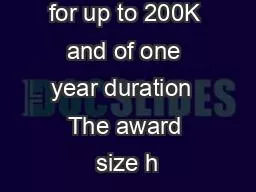/


1001 1001 ID: 893702
Download Pdf The PPT/PDF document "uests may be for up to 200K and of one y..." is the property of its rightful owner. Permission is granted to download and print the materials on this web site for personal, non-commercial use only, and to display it on your personal computer provided you do not modify the materials and that you retain all copyright notices contained in the materials. By downloading content from our website, you accept the terms of this agreement.
1 10-01 1
10-01 10-01 uests may be for up to $200K and of one year duration. The award size, however, will be consistent with the project scope and of a size comparable to grants in similar areas. No-cost extensions, and requests for supplemental funding, will be processed in accordance with standard NSF policies and procedures. Renewed funding of RAPID awards may be requested only through submission of a proposal that will be subject to full external merit review. Such proposals would be designated as “RAPID renewals.” EArly-concept Grants for Exploratory Research (EAGER) The EAGER funding mechanism may be used to support exploratory work in its early stages on untested, but potentially transformative, research ideas or approaches. This work may be considered especially "high risk-high payoff" in the sense that it, for example, involves radically different approaches, applies new expertise, or engages novel disciplinary or interdisciplinary perspectives. These exploratory proposals may also be submitted directly to an NSF program, but the EAGER mechanism should not be used for projects that are appropriate for submission as “regular” (i.e., non-EAGER) NSF proposals. PI(s) must contact the NSF program officer(s) whose expertise is most germane to the proposal topic prior to submission of an EAGER proposal. This will aid in determining the appropriateness of the work for consideration under the EAGER mechanism; this suitability must be assessed early in the process. The Project Description is expected to be brief (five to eight pages) and include clear statements as to why this project is appropriate for EAGER funding, including why it does not “fit” into existing programs and why it is a “good fit” for EAGER. Note this proposal preparation instruction deviates from the standard proposal preparation instructions c
2 ontained in this Guide; EAGER proposals
ontained in this Guide; EAGER proposals must otherwise be compliant with the GPG. The box for “EAGER” must be checked on the Cover Sheet. Only internal merit review is required for EAGER proposals. Under rare circumstances, program officers may elect to obtain external reviews to inform their decision. If external review is to be obtained, then the PI will be so informed in the interest of maintaining the transparency of the review and recommendation process. The two standard NSB-approved merit review criteria will apply. Requests may be for up to $300K and of up to two years duration. The award size, however, will be consistent with the project scope and of a size comparable to grants in similar areas. No-cost extensions, and requests for supplemental funding, will be processed in accordance with standard NSF policies and procedures. Renewed funding of EAGER awards may be requested only through submission of a proposal that will be subject to full external merit review. Such proposals would be designated as “EAGER renewals.” Facilitation Awards for Scientists and Engineers with Disabilities (FASED) As part of its effort to promote full utilization of highly qualified scientists, mathematicians, and engineers, and to develop scientific and technical talent, the Foundation has the following goals: to reduce or remove barriers to participation in research and training by physically disabled individuals by providing special equipment and assistance under awards made by NSF; and to encourage disabled individuals to pursue careers in science and engineering by stimulating the development and demonstration of special equipment rk performance. Individuals with disabilities eligible for facilitation awards include principal investigators, other senior project personnel, and graduate and undergraduate students. The cognizant NSF Program Officer will make decision